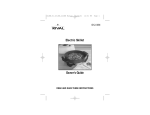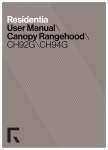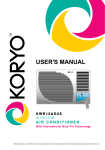Download T he K A M A D O Smoker & Grill C O O K B O O K
Transcript
KAMADO Pro Organized into 52 tutorials that combine a valuable kamado cooking technique with a delicious recipe, this book takes you from casual griller to kamado master chef with detailed instruction on: Grilling Cajun Strip Steak Smoking Hickory-Smoked Chicken Searing Cowboy Ribeye Brick Oven Baking Wood-Fired Pizza Stir-Firing Thai Beef with Basil Salt-Block Grilling Tropical Seared Tuna Cold Smoking Flavorful Fontina Cheese Convection Baking Apple Flambé $24.95 US Distributed by Publishers Group West IMPORTANT NOTE TO READERS: This book is independently authored and published and no sponsorship or endorsement of this book by, and no affiliation with, any trademarked brands of the kamado grill or other trademarked brands or products mentioned within is claimed or suggested. All trademarks that appear in this book belong to their respective owners and are used here for informational purposes only. The author and publisher encourage readers to patronize the quality brands and products mentioned in this book. The KAMAD O Smoker & Grill COOKBOOK Designed to do everything from slow smoke at 250°F to flash sear at 700°F, the kamado ceramic grill is the most versatile and powerful backyard cooker in the world. But to unleash its potential for amazing, crowd-pleasing barbecue, you need to have mastered your kamado inside and out. GROVE Become a KA MAD O The Smoker & Grill COOKBOOK Delicious Recipes and Hands-on Techniques for Mastering the World’s Best Barbecue Chris Grove Text Copyright © 2014 Chris Grove. Design and concept copyright © 2014 Ulysses Press and its licensors. All rights reserved. Any unauthorized duplication in whole or in part or dissemination of this edition by any means (including but not limited to photocopying, electronic devices, digital versions, and the Internet) will be prosecuted to the fullest extent of the law. Published by Ulysses Press P.O. Box 3440 Berkeley, CA 94703 www.ulyssespress.com ISBN: 978-1-61243-363-9 Library of Congress Catalog Number 2014932306 Printed in the United States by Bang Printing 10 9 8 7 6 5 4 3 2 1 Acquisitions editor: Katherine Furman Managing editor: Claire Chun Project editor: Alice Riegert Editor: Phyllis Elving Proofreader: Elyce Berrigan-Dunlop Front cover design: what!design @ whatweb.com Interior layout and design: what!design @ whatweb.com Illustration page 3: © Suman Kasturia Cover photograph: © Chris Grove Interior photographs © Chris Grove except: page 32 (top left) © Jay Prince; page 60 (bottom left/right), page 208 © Brandi Shive; page 21, 29 (right), 37, 67, 119, 128 (left) © Alexis Grove Food stylist: Alexis Grove Index: Sayre Van Young Distributed by Publishers Group West IMPORTANT NOTE TO READERS: This book is independently authored and published and no sponsorship or endorsement of this book by, and no affiliation with, any trademarked brands of the kamado grill or other trademarked brands or products mentioned within is claimed or suggested. All trademarks that appear in this book belong to their respective owners and are used here for informational purposes only. The author and publisher encourage readers to patronize the quality brands and products mentioned in this book. Take special note of the important safety warnings on page 4, page 7, pages 199–202, and elsewhere throughout this book, and always use customary precautions for safe food preparation, handling, and storage. Contents Introduction................................................................................................1 #1 #14 #2 #15 #3 #16 #4 #17 #5 #18 #6 #19 #7 #20 #8 #21 #9 #22 #10 #23 #11 #24 #12 #25 #13 #26 Paper Towel Lighting Method............ 19 Gas Torch Lighting Method................ 23 Direct Grilling........................................ 27 Indirect Grilling...................................... 31 Spatchcocked Poultry............................ 36 Smoking, Low and Slow.......................40 Smoking, Hot and Fast......................... 45 Cooking Wings over Direct Heat...... 49 30-20-10 Wings..................................... 52 Roasting Rack/Pan Combo..................55 Injecting Flavor...................................... 58 Using Brines.............................................61 Creating and Using Marinades........... 65 Dutch Ovens...........................................69 Convection Baking................................ 72 Sear/Roasting Steaks and Chops.........75 Reverse Searing Steaks and Chops.... 78 Reverse Searing Roasts..........................81 Hot-Tubbing........................................... 85 Stuffed Cheeseburgers.......................... 88 Stir-Firing................................................ 91 Brick-Press Grilling............................... 95 Plank Grilling.........................................98 Steam Cooking on a Kamado............ 101 Grill Toppers and Veggie Woks........104 Corn Three Ways.................................108 #27 #40 #28 #41 #29 #42 #30 #43 #31 #44 #32 #45 #33 #46 #34 #47 #35 #48 #36 #49 #37 #50 #38 #51 Wok-Top “Broiling”............................. 111 Raised Direct Grilling.........................114 Cooking with Stoneware..................... 117 Using GrillGrates.................................. 121 Grilling with Skewers......................... 124 Flexible Skewers................................... 127 Spider Rig Searing............................... 130 Pan Roasting.......................................... 133 Sous-Vide...............................................136 Cold Smoking........................................139 Salt-Block Grilling ............................. 142 Smoking with Electronic Controllers............................................ 146 #39 Breakfast on the Kamado....................152 Dip and Flip...........................................156 The Kamado as a Brick Oven............159 Baking Bread......................................... 162 Griddle Cooking.................................. 166 Blackening............................................. 169 Single-Serve Dishes............................. 172 “Because You Can”...............................175 Roulade-Style Roasts.......................... 178 Cast-Iron Skillets................................ 182 Coordinating Cooks.............................185 Beer-Can Chicken............................... 189 Grilling on the Coals............................191 #52 Prime Rib............................................... 194 Appendix: Troubleshooting........................................................... 199 Conversions.............................................................................................204 Index.............................................................................................................206 Acknowledgments................................................................................ 210 About the Author................................................................................. 211 Introduction I love green bell peppers, but my neighbor John doesn’t like them. I only point that out because when I started thinking about what to include in this book, it made me want to offer something besides just a bunch of recipes to follow. People have specific taste preferences, and if a recipe includes something they don’t like, they’ll either not make it or leave that ingredient out — which could drastically change the result. So instead of only recipes, I want to provide kamado owners with inspiration and a toolkit of ideas to help them explore what their ceramic cookers can do. I want to give readers tips and techniques they might not have tried before. My sister bought her first kamado grill about a year ago and we have had countless emails, phone calls, and texts about discovering her new cooker. I want this book to capture the essence of all of those back-and-forth conversations so the information can be shared with anyone else who wants to learn the ins and outs of kamado grilling. The tips and techniques that I share here aren’t the only way to do things. I don’t want to be “that guy” in barbecue forums who smugly berates someone because “you are doing it the wrong way.” For example, ribs that are “fall off the bone” are generally acknowledged as overcooked in the barbecue community, especially in competitions. But if that’s how you and your family like them, that’s how you should cook them. If you prefer to foil your brisket and like the way it turns out, who cares if some guy in Texas says it isn’t traditional? Regardless of what I may lay out in this book, I hope that you will cook according to your own preferences and style. I have often heard people mention that the kamado grill is a 3,000-year-old design. While the kamado, a wood-fired clay stove, has been in use in Japan for that long, the oval-shaped, self-contained grill is really a modern development. The kamado’s ceramics, airtight design, and vent controls make it much different than other grills. Kamados are extremely efficient with very little heat or moisture loss. You can run many kamados at 250°F Introduction 1 for over 20 hours on one load of lump coal. The design also allows kamados to handle volatile, hot temperatures upwards of 700°F. The ceramic construction acts as a heat capacitor, storing heat and then releasing it steadily for stable cooking temperatures and evenly cooked food. When you are done cooking, the airtight design allows you to extinguish the coals and re-use the leftover coal the next time you cook. Choosing Your Kamado Grill You can’t buy a better cooker for your home than a kamado-style grill. But this isn’t a sales pitch, because I’m assuming that if you’ve bought this book, you already own a kamado. In fact, I’m making a few assumptions based on my experiences with a lot of kamado owners. I suspect that you already have a basic understanding of grilling and maybe even smoking. If you’re like a good majority of kamado grillers, you probably are intelligent, have a bit of a tech-geek side, stay up on but don’t necessarily follow the latest trends, are open to ideas, and are a bit of a risk taker. Am I not too far off? But on the off chance that you’re just thumbing through, I’ll offer a few pointers 2 for buying a kamado grill. Kamados used to be limited to a few key brands, and you could only purchase them from authorized dealers. In the past few years, however, many new manufacturers have entered the game, and the number of places selling kamados has expanded rapidly. You can even buy them at big-box home improvement stores and warehouse clubs. And these aren’t just poorly made knockoffs either. Most are quality kamados, and some include innovations that top the established brands. Here are some things to consider if you are buying a new kamado today. Dealer or other retail outlet? With a dealer, you’ll get a properly assembled kamado, delivery and setup (in most cases), and local assistance in case of warranty issues, but you will pay a premium. At other retail outlets you often get more accessories included and a significantly lower price, but you’ll have to set up your kamado yourself and if things go wrong, you’ll deal directly with the manufacturer. Both have their strong points, so it’s a personal choice. Heft and feel. A well-made kamado will feel solid when you open and close the dome lid (and vent controls). Open and close a few different models, and you’ll quickly gain a sense of what feels like quality and what feels inferior. If it feels cheap (not the same as inexpensive), it probably is. The Kamado Smoker & Grill Cookbook 1 2 3 8 9 4 5 10 11 6 7 1 Top vent — also called dual-function metal top (DFMT), cast-iron vent, slide top 2 3 4 5 6 Dome thermometer 7 Cart — also called nest Dome lid Side shelves — also called mates Base 8 Cooking grate — also called cooking grid, main grate 9 Fire ring — on some models, the fire ring and fire bowl may be combined as one piece. 10 Fire bowl — also called fire box 11 Fire grate — also called coal grate Bottom vent — also called draft door, slide vent Kamado Terminology Different manufacturers have different terms for the various parts of their kamados, but the functions are mostly the same. For the purposes of this book, I’ll be referring to the most common size of kamado, roughly 18½ inches in diameter. Introduction 3 Terms of warranty. A limited lifetime warranty on ceramics and a five-year warranty on metal parts are common, but you also have to consider how long the manufacturer has been in business. Existing owners. The best information comes from those folks already using the specific brand. Check their user forums or go to a general barbecue forum like BBQ Brethren and search for comments on that brand. You will find a wealth of information— that is how I ended up buying my first kamado instead of the offset smoker trailer that I had my eye on. Read the Manual! This book is in no way intended to replace or supersede your kamado owner’s manual and manufacturer’s recommendations. You should thoroughly read the manuals and check out the manufacturer’s website for additional information. Most major manufacturers now have excellent online materials, including how-to videos and product-specific instructions. Fire Management The single most important skill for success on any grill is mastering control of the fire. I wish it was as easy as saying that to get 4 a kamado to 250°F, you simply open the bottom vent ¼ inch and have the top vent open ¼ inch. Unfortunately, there are no universal settings for temperatures because conditions change, manufacturers’ specifications vary, and there are just too many other variables. We own two kamados of the same brand and size, and even they don’t respond to the exact same settings. It would be like telling someone that to go 60 mph in a car, you hold your gas pedal 2.75 inches from the floorboard. You could be going uphill, downhill, or against the wind. You could have differing vehicle weights or tire pressures, and — well, you get the point. Your user manual will give some approximations for temperature settings, but these are just guidelines. Just as with driving, it will take experience to master fire control. However, there are steps you can take to shorten the learning curve. Coal Setup Is the Key Kamados function the best using quality lump coal, which is just pure wood that has been burned in an oxygen-poor environment. There are a lot of brands out there, but not all lump coal is created equal. Brands that use South American hardwoods are known for being “sparky,” The Kamado Smoker & Grill Cookbook some to the point of leaving debris on your food. Some brands have mostly smaller pieces, which can clog air vents. Other brands have mostly large pieces that need to be broken up with a hammer for even lighting. Many brands, including some kamado manufacturer labels, are actually third party labels packaged by a single lump coal producer. The best way to find out about different brands is The Naked Whiz website’s charcoal database (www. nakedwhiz.com/lumpindexpage.htm). Doug does a great job of giving impartial reviews using objective methods, keeping the reviews updated as brands change, and he also allows user reviews. The best practice would be to remove and reserve any used coal from your kamado each time you use it. Clean out the ashes and make sure all vent holes on the inside are clear. In general, coal should be loaded to just above the air holes in the fire bowl, but as always, follow manufacturer instructions. When doing a long low-andslow cook, I (and every kamado user I know) load the coal to at least the top of the fire bowl; some even cheat up into the fire ring. Load fresh lump at the bottom and top it off with the used coal that you’ve saved. This will give you the fastest starting and most trouble-free fire. If you have blocked air holes, your airflow will be restricted, and that will affect how well your temperature reacts to opening and closing the top and bottom vents. Notice that I said “best practice.” Honestly, if I’m doing a short cook at a medium-high temp, sometimes I’ll cheat and just push the used coal to one side, adding new coal in the void. But for long-term or high-temp cooks, I clean it out first. Lighting the Grill You don’t light a kamado the way you light most other grills. Sure, you can dump in a chimney full of lit coals, but you instantly lose the benefit of the kamado’s tight air controls. Two specific lighting options are covered with the first two recipes in this book (on page 19 and page 23), but kamados are generally started by putting in unlit lump coal and using starter cubes, electric starters, or gas starters. With a fresh load of lump coal in a clean kamado, you can reach grilling temperatures in as little as 15 minutes. With used coal and ash mixed in—if you fail to clean it out as mentioned above, it can take twice as long. Ironically, it takes longer to get the kamado smoking at 250°F than it does to start grilling at 350°F because you are waiting for the smoking wood to produce a clean smoke, which can take up to 45 minutes sometimes. Vent Position One thing that can help you get acclimated to using the bottom vent is to mark ½-inch increments on the slide vent, if not already Introduction 5 done by the manufacturer, so you’ll have a good idea how far it’s open. It’s more helpful to recognize that the vent is open one inch than to see that it’s open “a little bit.” Some top vents are adjusted by screwing up or down, and those stay in place when you open the dome lid. But most use a sliding disc on a cap, and when you open the dome lid gravity is going to pull it downward, changing your setting. To avoid this, start at the pivot screw that holds the sliding disc and imagine a straight line going right across it. If you always rotate the cap so the imaginary line is aimed toward the back, as pictured below, it will stay in place when you open the lid. Coast to Your Cooking Temperature Stopping the temperature at your desired cooking temperature is much like docking a boat — you have to start slowing down before you get there. For example, if my target is 350°F, I might close the bottom vent from wide open to about halfway shut when the temperature reaches 275°F. Then as it hits 300°F, I’ll close it a little more. If 6 the temperature is still rising when it hits 325°F, I might close it down even farther so that I coast up to 350°F. If you’re coming to a kamado from other grills, you will quickly notice that your vents are significantly more effective at controlling the temperature with this grill. Don’t Flip Your Lid Kamados are designed to be used with the dome lid closed, and it should be kept closed as much as possible while in use. The tight tolerances and high efficiency of the kamado depend on it being operated as a closed system with the airflow closely controlled by the lower and top vents. For all recipes in this book, presume that all cooking is done with the dome lid closed unless I explicitly instruct to leave the lid open. Cooking with the dome lid shut is the default mode when using a kamado because that closed system is what regulates temperatures. Every time the dome lid opens, the vents are pointless and the coals get unlimited access to air, causing the temperature to The Kamado Smoker & Grill Cookbook Fire Safety What’s a flashback? Good question, let’s talk fire safety for a minute. Once again, you should read and heed your manufacturer’s user manual and all safety instructions. A flashback is a quick way to remove your eyebrows, or worse. This is a phenomenon specific to kamados because of their tight air controls — but it isn’t a design fault, rather a condition caused by fire management. You just don’t notice it in most other types of grills because they have so many air leaks that flashback conditions are less likely to occur. To have a fire, you need the “fire triangle” — heat, oxygen, and fuel. If you have a hot fire in the kamado and suddenly cut down the airflow by closing the bottom vent, you’ve created a fire that is starving for oxygen. When the dome lid opens, air rushes in and the superheated gases (volatile organic compounds) suddenly ignite in a fireball that jumps up and out of the kamado — right to where you are standing. It can cause serious burns and is no joke. The way to avoid a flashback is to re-introduce air slowly. Crack the lid open just an inch a few times in rapid succession before you open it all the way. Train yourself to do this every time you open your kamado. This is also one more reason that you should always wear personal protective equipment (PPE), such as safety glasses and longsleeved heat-resistant gloves. When it comes to gloves, there are a lot of options out there, but you have to be careful in choosing. Silicone oven mitts are quite the rage in the kitchen because they are comfortable, handle “high heat,” and come in cute shapes that look like pig or cow puppets. But your kamado can generate much higher temperatures than most home ovens. The hot ceramics of a heat deflector can melt or burn through many kitchen oven mitts in seconds. Heavy-duty leather welding gloves work better for grilling duty. Even with these brutes, you have to handle hot ceramics very quickly and have a “landing spot” already cleared and waiting. Introduction 7 Are you “screening your coals”? Lump coal is a natural wood product that often will pop at high temperatures. Sometimes this sends a hot cinder shooting out of the bottom vent. If your kamado bottom vent has a secondary slide screen, keep it closed to contain those cinders. That brings up another couple of points. Don’t leave a burning grill unattended. Using a grill mat under your grill to minimize damage from errant coals is especially recommended if you are grilling on a wooden deck. Don’t skimp on a cheaper gas grill mat. Those are much less expensive, but they are only meant to resist greasy drippings and aren’t fire resistant. rise. But what can you do when you use a technique that requires frequent opening for food handling, such as cooking on a wok or griddle? First, in such cases I’ll start off a little lower than my intended temperature because I know it will rise during the cook. Second, I’ll have everything I need before I open the lid, and I’ll work quickly. Third, I’ll shut the lower vent to about ½ inch after I shut the dome lid, to settle down the fire. You do have to be careful with the third step because this can set up a flashback. Maintenance Any grill requires cleaning and maintenance to perform at its peak, and the kamado is no exception. You should follow the specific 8 maintenance recommendations in your user’s manual, but here are some general guidelines. Every Time Each time you use your kamado, clean out the ashes from the prior use and make sure the internal air holes are clear. I keep a lidded metal bucket and dustpan near our kamados for this purpose. Small coals can remain alive for hours insulated in the ash, so never dump ashes straight into a trash can. Quarterly Even if you do the light clean-out every time you use your kamado, some ash will fall through the fire box air holes and end The Kamado Smoker & Grill Cookbook up between the fire box and kamado base. Unless you have spaghetti noodles for arms, you won’t be able to reach around to these spots through the bottom vent. Over repeated use, these little bits will build up into piles big enough to block airflow around the fire box. To clear the debris, you have to remove the interior ceramics and sweep out the kamado base. Some people get around this by using a shop vac rigged with a piece of flexible rubber hose that fits through the vent and around the back. Only do this if your grill hasn’t been used for several days, because of the threat of live embers lurking in the ash. High-Temp Clean Burn Over time, buildup will occur on the inside of your kamado. This happens faster with low-and-slow cooks than it does if you’re mostly just grilling. But eventually it will build up, impairing the ceramic’s ability to reflect heat. You can clean off this buildup by using a high-temp clean burn. Here’s one way to do that. 1 Remove the internal ceramics. Use a wire brush or a ball of crushed aluminum foil to scrub the interior walls. Don’t worry about getting everything — this is just a “pre-scrub.” 2 Replace the internal ceramics and fill the fire box with coal. Open the bottom and top vents all of the way, light a fire, shut the dome lid, and let it burn until it runs out of coal. This will take just a couple of hours at the extreme temperatures, and the ceramics will get quite hot. Let the kamado cool overnight. 3 Once cooled, remove the internal ceramics again and repeat the brushing. This time, all the crud should come off easily as black dust that can just be swept out. 4 Put everything back together and you’re done. Finally, routinely check the tightness of the bolts that tighten the metal bands that hold the exterior ceramics in place. These can loosen over time and often after high-temp Introduction 9 clean burns. If you let them get too loose, the dome lid could actually fall off when you open it. Don’t Blow a Gasket, Man! The gasket or seal between the dome lid and base is the Achilles’ heel of the kamado. Manufacturers recommend cooking at lower temperatures for the first few times to cure the adhesives. It’s so common to damage the gasket at high temps that I consider it more of a consumable supply than a part. You are most likely to torch a gasket in two situations. One is when the dome and base aren’t properly aligned, so that some of the seal is directly exposed to heat. The other is a high-temp cook with the heat deflector in “legs down” position, because this directs hot gases outward right at the level of the seal. The good news is, you really don’t need a gasket. I ran a kamado with no gasket for almost four years without any ill effects, even on long low-and-slow cooks. So one option is to not replace the gasket if you toast it by accident. Another option is replacing the torched gasket with a high-temperature gasket made from fire-resistant Nomex. Removing the old gasket can be difficult using hand tools, but a 3M paint and rust stripper pad 10 on a drill will make quick work of it without damaging the ceramics. Yet a third option that a lot of kamado owners have used is replacing the gasket with a wood stove rope-style gasket. It should be noted that the makers of these gaskets haven’t approved them for food handling, so read about the potential risks before going this route. We replaced one of ours with such a gasket, and it has survived more than 100 cooks without incident. Accessorizing . Is Everything! There seem to be an infinite number of grilling accessories, many specifically for kamados. As a grilling blogger, I have an inbox full of the latest offerings. Some are innovative and impressive, while the majority are just toys or gimmicks. Here are some of the more useful grilling accessories, in my opinion. Must-Have Accessories Instant-read thermometer. This is the only way to truly know if your food is properly cooked. You want a highquality thermometer that’s truly instantread — meaning three seconds or less. If The Kamado Smoker & Grill Cookbook you’re grilling six steaks and use a slow thermometer, the time it takes to check all six steaks is enough to go from mediumrare to medium. The gold standard among serious grillers is the Thermapen by Thermoworks. Remote probe thermometer. This thermometer’s wired probe lets you continuously monitor internal temps while food is cooking. This is essential for smoking, roasting, and reverse searing. Upper-end models include options such as dual probes (to measure cooking and internal temps at the same time), wireless capability, and some data logging. Heat deflector setup. This is needed for most indirect setups on the kamado. Most kamado brands include the deflector as part of the package, but not all do. If yours doesn’t come with a deflector, you will definitely need to buy one. Leather welding gloves. Found at home improvement stores, these are long-sleeved and heavy-duty. They work better than any oven mitts that I’ve tried and usually are just as cheap. Quality wire brush. Loose brass bristles can get on food and cause serious intestinal injuries. Cheap brushes often have short lengths of wire stuck into holes, making it easy for them to fall out. Quality brushes fold longer lengths of wire and pin them down in the brush, making them less likely to be dislodged. Wiggle rod. This is just a wire rod with a bent tip, used for clearing any blocked holes that develop during a cook. Just take a metal skewer and bend 1 inch of the tip at a 90° angle. Slide it through the bottom vent, stick it up through the fire grate holes, and wiggle it to dislodge any ash or small pieces of coal blocking the airflow. Pizza stone. Some models made for home kitchens are too thin to handle the heat of a kamado, so spend the extra money to get a thick, grill-safe pizza stone. Raised cooking grid. These are very useful for adding capacity and for cooking “raised direct” (page 114). Manufacturers offer different styles, or you can easily build your own as described on page 114. Introduction 11 Long-handled tongs. Kamados generate some serious heat, and you don’t want to be burning your knuckles while turning 30 chicken wings with six-inch serving tongs. Drip pan. This will keep your heat deflector clean and avoid a greasy fire. Foil pans work, but you can’t beat a 13-inch, foilcovered deep-dish pizza pan. Accessories That Are Nice to Have Cast-iron grates. I had a hard time not putting this into the “must have” category, but there are plenty of people who have great success just using standard stock grates. Cast-iron grates have excellent heat conductivity and sear gorgeous crosshatch marks. I use them for almost every cook, even when I’m not searing, because I think they help with even heating and are easier to maintain when used frequently. The down side is that if you don’t use them often, they can rust quickly if they’re left out or get damp where stored. Aftermarket fire grates. A few companies are offering fire grates that use different configurations than the standard holes in a cast-iron disc, which gets clogged. HighQue makes one with stainless-steel bars, and the Saint Louis Charcoal Company offers one made of expanded stainless steel. These aftermarket fire grates replace 12 the stock grate and greatly eliminate fire management issues caused by clogged air holes. Table. While the standard carts and shelves provide some working space, I greatly prefer the stability and work area that a kamado table provides. Plus, if you buy an unfinished stock table from a supplier, you can add your own custom touches, such as a tile top and varnish or stain. Stoneware. Stoneware pans, pie plates, and loaf pans will help you get the most out of your kamado as an oven. While metal pans can be used, I find that stoneware’s heat conductivity provides more even cooking. Electronic controllers. These devices can regulate a kamado with a PID controller that reads the cooking temperature and turns a fan mounted on your bottom vent on and off as needed. Read more about electronic controllers on page 146. Lighting system. A gas torch (page 23) or an electronic starter is the easiest and quickest to fire up your kamado. Wok. The kamado is the perfect setup for stir-firing (page 91). A wok will help you incorporate quick, healthy meals into your grilling routine. The Kamado Smoker & Grill Cookbook Temperatures for Cooking Meat Rare Medium Rare Medium Medium Well Well USDA Minimum (as of 6/15/13) Beef, Veal, and Lamb Steaks & Chops Approximate Cooking Times for 1-inch Steak at 450°F Whole Roasts 125–130°F 130–135°F 135–140°F 150°F 160°F 145°F with 3 minute rest 3 minutes per side 4 minutes per side 4–5 minutes per side 5–6 minutes per side 7 minutes per side 5 minutes per side 125–130°F 130–135°F 135–140°F 150°F 160°F 145°F with 3 minutes rest Ground Meat 160°F 195–205°F “like butter” test Brisket Pork Chops 145°F 160°F 145°F Roasts (Loins, Tenderloins) 145°F 160°F 145°F Ham (Fresh, Raw) 145°F 145°F Ham (Cooked) 140°F 145°F Butts, Shoulders 195–200°F Ground 160°F Poultry White Meat 160°F 165°F Dark Meat 175–180°F 165°F 165°F 165°F Ground Fish Dense Flesh like Tuna, Salmon 120°F 145°F Other Fish 140°F 145°F Introduction 13 Rack/pan combo. If you ever plan on doing roasts on your kamado — and you should — you’ll want some type of roasting rack and a pan to fit under it. Grill pan/veggie wok. These are typically some type of metal pan with small holes that allow for quick cooking of loose vegetables on the grill top. GrillGrates. These go on top of your normal cooking grate (page 121). They prevent flare-ups (which shouldn’t be a problem on a kamado) and channel the heat through raised ribs that give supercharged sear marks. If you like to show off well-defined grill marks, these are for you. Kamado Culture Kamado owners are a unique bunch and are extremely willing to share their ideas. I would highly recommend that you get involved in an online kamado forum, at least while you learn to master your grill. Most manufacturers operate a forum, some more active than others. Other forums are not brand specific. Find one that you are comfortable with and at least lurk, reading what other kamado users are up to. Some brands have festivals at which users get together regionally once a year to celebrate the kamado. Festival-goers grill recipes for sampling, exchange techniques, 14 tell tall tales, and have an adult beverage or two. These are good fun and definitely worth the trip. Basic Recipes These are recipes that I developed while writing my grilling and BBQ blog, Nibble Me This, over the past few years. They are staples that I use frequently at home and throughout this book. NMT Basic BBQ Rub This simple, all-purpose BBQ rub is good with both chicken and pork. I like to use oregano and thyme leaves for my dried herbs. Makes 1½ cups ½ cup smoked paprika ¼ cup packed dark brown sugar ¼ cup turbinado sugar ¼ cup kosher salt 5 tablespoons garlic pepper seasoning 2 teaspoons dried herbs of your choice 2 teaspoons chili powder 1 teaspoon chipotle chile powder 1 Mix all the ingredients together and store in an airtight container. Grind for finer texture right before using. The Kamado Smoker & Grill Cookbook NMT Cajun Beef Rub This is the mix I use when I want a beef rub that has the flavors of the Bayou. Makes about ¼ cup 2 tablespoons smoked paprika 2 teaspoons kosher salt 2 teaspoons onion powder 2 teaspoons garlic powder 1 teaspoon cayenne 1 teaspoon red pepper flakes 1½ teaspoons white pepper When I’m cooking beef steaks, roasts, or brisket, ½ teaspoon black pepper this is the rub that I often use. It’s best when 1 teaspoon dried thyme stored with the coarse bits intact, then freshly ground to use as needed. I use Bourbon Barrel 1 teaspoon oregano NMT Beef Rub Smoke Sea Salt, and I get my dried bell peppers from Penzeys Spices (3/8-inch-cut flakes). Makes about 1¼ cups 5 tablespoons coarse smoked salt 2 tablespoons black peppercorns 1 tablespoon green peppercorns 1 tablespoon dried minced garlic 1 tablespoon dried red and green bell pepper flakes 2¼ teaspoons dried minced onion 2 teaspoons dried thyme leaves 1 1 Mix all the ingredients together and store in an airtight container until ready to use, for up to 6 months. Mix all the ingredients together and store in an airtight container. Grind to a finer texture just before using the rub. Introduction 15 NMT Burger Mix-in NMT Blackening Seasoning Many commercially available burger seasonings look like they have thrown the entire spice cabinet into a jar. I like this one because it is so simple, providing the classic burger flavor without over seasoning it. Just adding this seasoning to a protein does not make it “blackened.” Season it with this rub and then cook on a fiery hot cast iron, while drizzling the meat with butter. Makes 2 tablespoons Makes about ½ cup ½ tablespoon paprika ¼ cup kosher salt 1¼ teaspoons kosher salt 2 tablespoons ground black pepper ½ teaspoon onion powder 1 tablespoon dried minced garlic ½ teaspoon garlic powder 1 tablespoon dried minced onion ½ teaspoon cayenne pepper ½ teaspoon black pepper ½ teaspoon white pepper 1 Mix all the ingredients together and ¼ teaspoon thyme, ground store in an airtight container. To use, mix ¼ teaspoon oregano, ground in 1½ teaspoons per pound of ground ¼ teaspoon celery seed beef. 1 16 Mix all of the ingredients together and store in an airtight container for up to 6 months. The Kamado Smoker & Grill Cookbook NMT Spicy Poultry Rub NMT Cherry BBQ Sauce This spicy poultry rub is good for grilling chicken with a bit of a kick to use in sandwiches, tacos, or wraps. This sweet and spicy sauce goes well with both chicken and pork. Makes about 2 cups Makes ¼ cup ⅓ cup ketchup 2 tablespoons seasoned salt ¼ cup Sweet Baby Ray’s Barbecue Sauce 2 teaspoons turbinado sugar ½ cup cherry preserves 2 teaspoons smoked paprika ¼ cup cherry juice 1 teaspoon ancho chile powder ¼ cup packed dark brown sugar 1 teaspoon chili powder 3 tablespoons apple cider vinegar 1 teaspoon ground black pepper 1½ tablespoons chipotle hot sauce 1 teaspoon garlic powder ½ tablespoon Worcestershire sauce 1 teaspoon dried oregano ½ teaspoon dried minced garlic 1 teaspoon dried orange peel ½ teaspoon dried onion flakes ¼ teaspoon ground black pepper ¼ teaspoon ground cumin, 1 Mix all the ingredients together and preferably roasted ground cumin store in an airtight container. ⅛ teaspoon ground coriander ⅛ teaspoon liquid smoke 2 or 3 pinches chipotle chile powder Smoked salt to taste (about ½ teaspoon) 1 Mix all the ingredients together in a saucepan on the stovetop. Bring to a simmer over medium heat and let simmer for 5 minutes, stirring occasionally. Blend to a smooth consistency using an immersion blender. Let cool, place in an airtight container, and store in the refrigerator for up to one month. Introduction 17























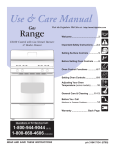
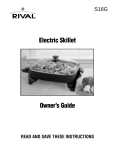
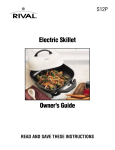


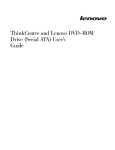
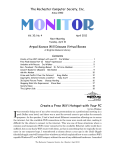


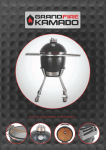

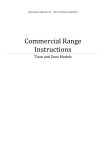
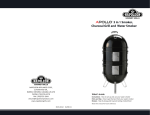


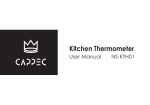

![Identifying Embeded Web Servers - [media.blackhat.com]](http://vs1.manualzilla.com/store/data/005833288_1-dd26f65aacb79f754f7b5aa134b8197a-150x150.png)
